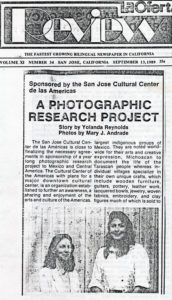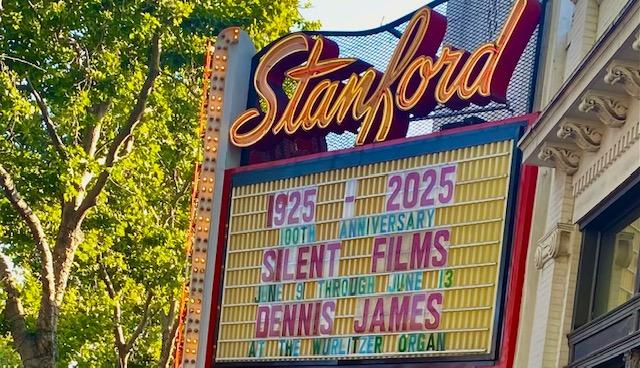In San Jose History, under the Local section of La Oferta will start publishing again some of the articles that for several years wrote Mrs. Yolanda Reynolds. They focused on the different aspects of the City, and they represent the political, social and educational development of our community. This articles are part of the history of how San Jose grew facing many issues. They are in essence a testimony of the dedication and involvement of Mrs. Yolanda Reynolds researching and presenting each story.
We’ll start with the first article that La Oferta published on September 13, 1989.
Mary J. Andrade, Editor
Sponsored by the San Jose Cultural Center de las Américas
A Photographic Research Project

The San José Cultural Center de las Américas is close to finalizing the necessary agreements in sponsorship of a year long photographic research project to Mexico and Central America. The Cultural Center of the Americas with plans for a major downtown cultural center, it is an organization established to further an awareness, a sharing and enjoyment of the arts and culture of the Americas largest indigenous groups of Mexico. They are noted worldwide for their arts and creative expression. One of their stop will be Michoacan to document the life of the Tarascan people whereas individual villages specialize in their unique crafts, which include wooden furniture, guitars, pottery, leather work, lacquered bowls, jewelry, woven fabrics, embroidery, and clay figures much of which is sold to tourists and intermediaries.
Elizabeth Reid and Janine Coover both of Soquel, California, met with the Board of Director’s, last week. Elizabeth’s interest in embarking on this project began a number of years after a weeklong trip with friends to the usual tourists stops in Mexico; Mexico City, Acapulco, Guadalajara. That trip was followed the next year with a four months solo trip throughout Mexico. Much of her time was spent among Maya Indian villagers along the Guatemala-Mexico border. To visit some of the sites required a two day back pack trip to visit, as there were no roads.
A mutual interest in Latin America and photography brought Liz and Janine together. They found that their interests not only coincided but their special interests and skills were complementary. Janine is a writer and Liz has more experience as a photographer. Their collaboration will enable them to document in prose and photography the traditions and everyday life to selected areas of Mexico and Central America.
Their plan is to spend the first two months in Parramos Chiquito, Guatemala and San Juan Chamula, Mexico. Both areas that Liz had previously visited and found very intriguing. Other month long stays are planned for the Lancandon Rain Forest in Chiapas, Mexico, home of the Lancandon Mayas of whom there are only 400 remaining who hold on to their pre-Columbian traditions and religious beliefs.
Later the researchers plan stops on and about; Cuna, Panama where the people of the San Blas Islands off the Northeast coast of Panama are believes by the researchers to have remained the most well organized of the native societies from this region. This Maya community has built a strong economic base by maintaining markets in the surrounding areas, while preserving their native customs through isolation from the continent (having fled these islands to escape the encroachment of Spanish society.
By mid 1990 they will probably be in Oaxaca state, Mexico where they will be among the Zapotecs, who are one that hold expensive fiestas at regular intervals; later on they will travel to Northern Jalisco to be among the Huichol. The Huichol are located in the remote northern part of Jalisco. Because of their mountain sanctuary, it is felt that this group has been little affected by outside influences. The Huichol are reputed to have retained their ancient beliefs in the spirits of nature and encourage personal spirituality among the community rather than a more formalized religious system. The feast on the Ripe Fruits at harvest time involves women and children as the primary participants, as it is the festival of fertility. Peyote plays a very large role in their religious practices, with most of the members of the village partaking. Visions resulting from the use of the drug, are said to inspire fantastic yarn paintings which are constructed as visual prayers requesting the wishes of the supplicant.
Liz and Janine will go on to the Valley of Mexico to be among the Nahua, the descendants of the Aztec people. The Nahua still speak a dialect of the ancient Aztec language. The family structure is considered to be very interesting. The husband is the titular head of the family but the wife retains almost absolute control over the family wealth. Their travels will take them to Veracruz, to be among the Totonacs revolve around a great number of complex and described rituals. Children are “married” at birth in the belief that it will prevent illness. Young women are given in marriage or at least greatly restricted at the same time of their first period. Totonac ceremonies, aside from the usual drinking, dancing, and feasting include candle burning and the burning of copal.
The researchers year long stay will end a month long visit to the Tarahumara in their mountain refuge near Chihuahua. These people are reputed to have a rather egalitarian society. They are semi nomadic moving with the seasons while living in either temporary dwellings or caves. Men and women share the duties, which is based on personal preference and necessity. In the family, property ownership is well defined, with joint property divided equally when partners divorce. The Tarahumara are noted for their foot races. They are reputed to be able to run distances as long as 500 miles without taking a rest.
The emphasis of this photo documentary will be the day to day life in the rapidly changing world of the women of the areas that they plan to visit. In the researchers words “it is important to concentrate on the study and documentation of indigenous cultures especially the lives of the women whose story is often untold or misrepresented. The researchers will be exploring their the women’s unique traditional roles and recording their ideas and customs for future generations.”
Liz and Janine have prepared for this extensive excursion for some time. Both have taken intensive Spanish language courses, in depth courses in Latin American History and Pre-Columbian studies. Liz’ other interest is sport and sport photography. She is the only female in a Mexican-American soccer team in Salinas, which besides playing soccer gives her the opportunity to speak Spanish to her teammates.
Liz and Janine have received much notice for their planned research project. They are hoping to receive more grants of money to facilitate an support the extent of their planned research.
Their plans are to depart from the U.S. January 1, 1990. They will be traveling by bus to Guadalajara, Mexico City, San Cristobal de las Casas and on to Antigua for their fist leg of the journey. By February they plan their first month stay to begin among the Quiche Maya in Parramos Chiquito, Guatemala.






